Efficient materials handling is at the heart of every thriving agricultural operation. From planting to harvesting to processing and packaging, the movement of goods and produce needs to be seamless, says Donghua, manufacturer of chain and chain products.
Modern-day farms are sophisticated hubs of productivity, and the need for cutting-edge technology and efficient processes is critical. That’s where Donghua says its chain comes in – providing a vital link in material handling, the company reckons.
The Hangzhou Donghua Chain Group boasts a rich history of producing high quality, innovative chains in its state-of-the-art facilities. Its agricultural chain is designed to meet the diverse and demanding needs of modern farming, making it a trusted partner for farmers across the UK.
Key advantages of agricultural chain
- “Unparalleled durability” – built to withstand the harshest of conditions, ensuring continuous operation even in the most challenging environments
- Precision engineering – engineered with precision, resulting in minimal wear and tear providing end-users with reduced downtime and maintenance and allowing farmers to focus on what they do best
- Enhanced efficiency – designed to optimise efficiency, reduce labour costs and increase overall productivity
- Versatility – a range of options from roller chains to conveyor chains, ensuring there’s a solution for every material handling requirement
- Unique features – designed with super-high breaking loads, heat treated and pre-tensioned with chrome pins, and high interference between pins and plates.
Donghua’s UK headquarters in the West Midlands includes a 25,000 sq ft warehouse, technical workshop and testing laboratory. With approved product partners, approved stockists and distributors across the UK and Ireland, the company says it is well placed to support farmers when they need replacement agricultural chain. Donghua produces chain for all the major farm machinery manufacturers.
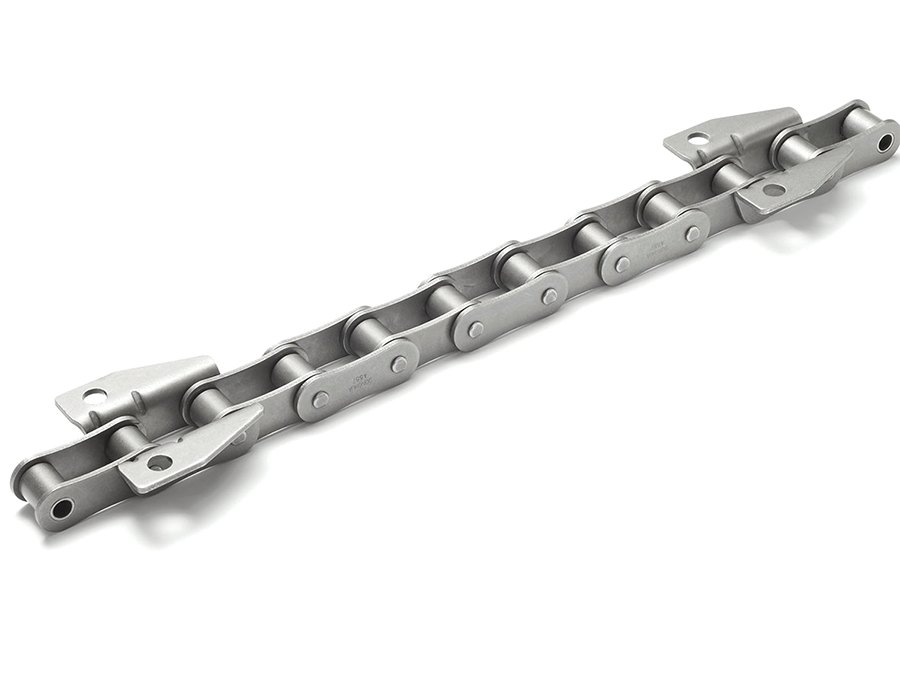
Donghua agricultural chain is engineered with precision, resulting in minimal wear and tear providing end-users with reduced downtime and maintenance.
What does the chain range include?
Donghua’s chain range includes the following products:
Heavy Super Power (HSP) Chain – This is popular in the UK as it’s incredibly robust with ultimate tensile strength up to 50% than DIN standard chains. Its wide waist plates give extreme fatigue strength and high interference between pins and plates. It is ideal for use on balers, Donghua reckons.
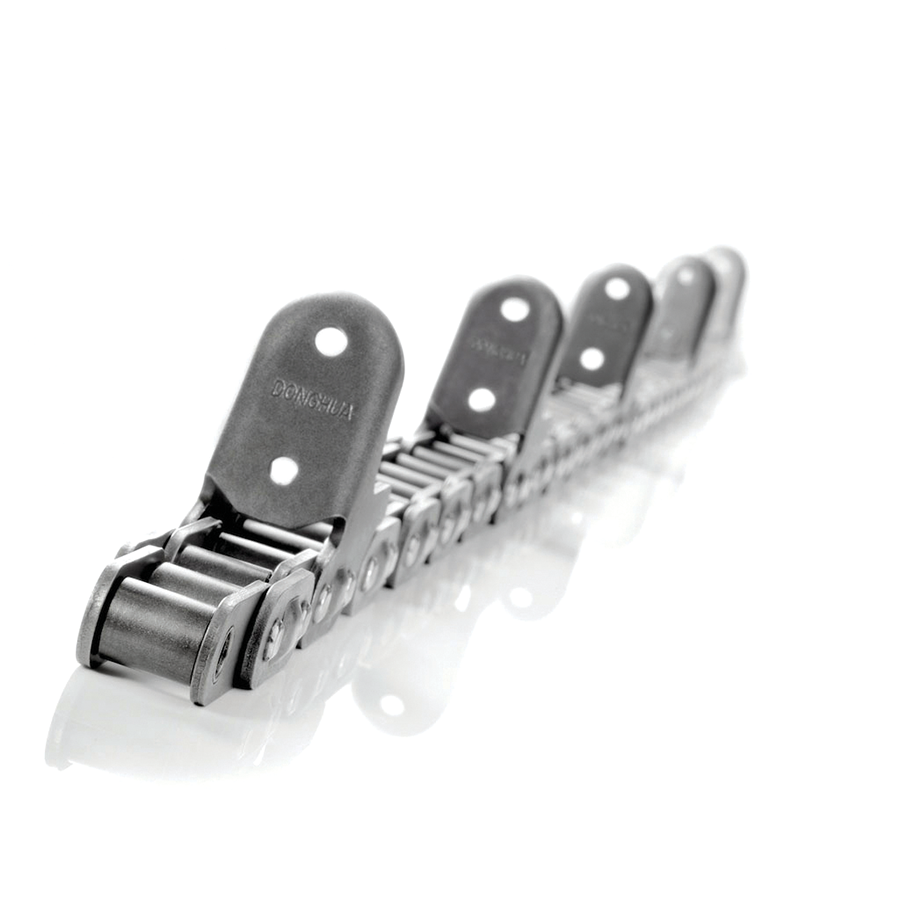
The Hangzhou Donghua Chain Group boasts a rich history of producing high quality, innovative chains in its state-of-the-art facilities, the company says.
Mark V agriculture chain – A range of zinc coated chain providing added durability. It is anti-corrosive, waterproof and longer lasting than standard agricultural chain, and built in the UK workshop.
Pintle chain and attachments – Designed with an open barrel which minimises pin surface contact with the chain gearing face, it cleans the tooth root and removes any lodged material during use minimising material build-up which causes blockage, corrosion and potential seizure. Heat-treatment of parts during manufacture, including hardened steel pins, optimises wear-life making the Pintle Chain highly durable.
Combine replacement chain kit– Donghua also offers a complete replacement chain kit for each make and model of combine harvesters used in the UK. It can identify the correct chain from the make and model or the OEM part number.
When you need to unlock the efficiency of your farm machinery, Donghua says it is the only manufacturer with a full range and large stock of agricultural chain ex-stock in the UK. For more information, visit https://www.donghua.co.uk/agriculture-chain/ or contact the company directly.
AGCO is a global leader in the design, manufacture and distribution of agricultural machinery and precision ag technology. Its differentiated brand portfolio includes core brands like Fendt, GSI, Massey Ferguson, Precision Planting and Valtra.
Meanwhile, BWT, based in Essex, is an experienced and trusted supplier of complete wheel and tyre sets for agricultural machines, including the recently introduced 3S Wheel.
AGCO says it chose BWT as its partner for aftermarket wheel solutions in the UK due to BWT’s extensive market insight, fuelled by its family farming background, and passion for ensuring customers receive the right products and valuable guidance to boost yield and reduce costs.
Within the BWT team are product specialists available to help with product selection with an unbiased, pragmatic approach. BWT also offers an app which provides advice on how to optimise setup of the machine, helping the user to understand a range of topics, including correct weight distribution for the tractor, correct amount of ballast, what horsepower the tyres can take, and the correct amount of wheelslip.
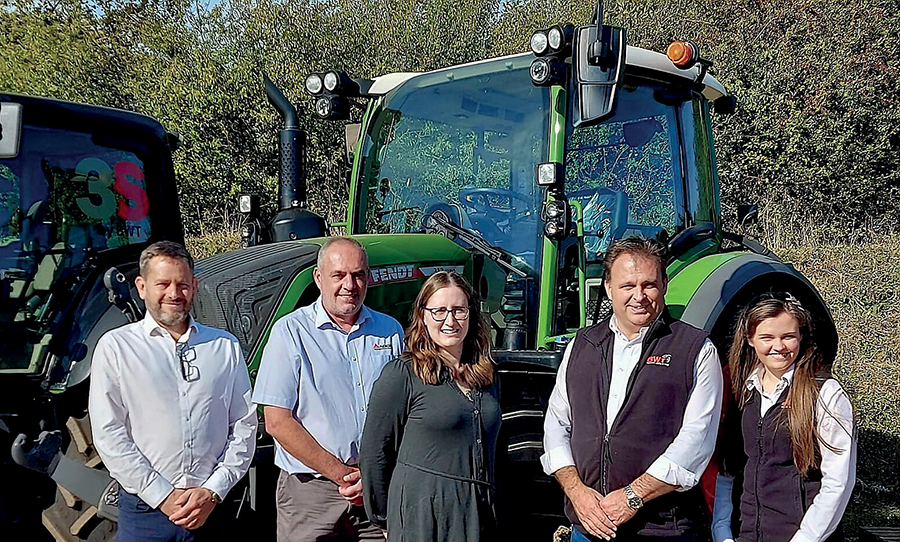
(l-r): AGCO national aftersales manager, commercial UK & Ireland, Jason Webb; AGCO aftersales commercial manager, John Elliott; AGCO complementary product manager, UK and Ireland, Emily Pryce; BWT sales director, Will Brock; and BWT marketing manager, Mikayla Brock.
Farmers will receive access to advice and expertise that will increase profitability and efficiency through the latest advancements in wheel technology, the companies say. All their requirements will be available in a ‘one stop shop’ through the AGCO network, including BWT’s products and expertise.
BWT director Will Brock said: “We are privileged to partner with AGCO and are looking forward to sharing our experience with many new contacts through this exciting new distribution channel. Our collaboration extends beyond business. We’re committed to making a positive impact on the people we serve, not only by business growth but by giving back to communities in need.
“Leading solutions will now be accessible to a broader spectrum of businesses and individuals, opening doors to growth and success. We are looking for this to be a long-term partnership and are backing it up with industry-leading warranties.”
AGCO manager, national aftersales, commercial UK & Ireland, Jason Webb added: “We are excited to work with the BWT team to develop our key product offerings, ensuring our customers receive objective technical guidance and advice about the right product for the job. The partnership will strengthen our dealer product portfolios by providing customers with the solutions they need under ‘one roof’, saving our farmers time and hassle.”
For more about AGCO and BWT’s partnership, visit https://bwt.uk.com/agco.
While many hire companies tend to order a base spec machine, all of Ardent’s machines come with air con as standard, and many more bells and whistles – such as hydraulic fork positioning, chassis levelling and extra protection guards and sound proofing – Gareth says. All machines also have a keypad to help prevent theft.
The most popular machine, in Ardent’s experience, is the JCB 532/542/536-95 Agri Super or Xtra telehandler. The company has a number of these in its fleet now – many machines are ordered each year for confirmed hires.
“These machines are all about horsepower and spec; they are the GTI of telehandlers. They have extra speed, extra hydraulic capacity and speed, and the operator cab environment is that of a high-end car,” Gareth explains.
The Ardent team has excellent knowledge of JCB and Manitou telehandlers and these make up the most of the fleet, but other brands can be considered, he continues. The company can also add different headstocks to suit customers’ attachments. It has been a long-standing customer of both JCB and Manitou for many years now, with relationships at a senior level.
“We have confidence in both brands – they are both industry-leading recognised brands with good service and back up, parts are readily available and the controls are common across the models. We stock a high volume of parts to ensure we fix machines should they be damaged or have a fault on the first visit,” Gareth says.
The latest machine in the fleet is the JCB 560-80, which has been a real hit. “The machine has the capacity to lift six tonnes and can reach 8m; it brings lots of exciting extras and has the appropriate horsepower for a machine that size. Like the Agri Super/Xtra machines, this machine benefits from the latest generation cab and technology. It has high-capacity lift and the DNA of an agri machine.”
For many farms, hiring rather than purchasing offers a number of advantages. “You know what your costs are, and we maintain the machine including servicing and thorough examination certificates – all the hirer is responsible for is damage. In the event of breakdown and if we can’t fix the machine the same day, we will bring a courtesy machine out to be used until the machine is fully repaired, ensuring daily duties can continue. We understand a machine is required for tasks that can’t wait, so minimising downtime is our priority,” Gareth concludes.
Hugh Crane was formed in 1983 to satisfy the demand for high quality agricultural cleaning equipment.
With over 40 years’ experience in the cleaning equipment industry and a close working relationship with many of the world’s leading equipment manufacturers, the company can match the right equipment to a specific task, providing efficiency and value for money. Great emphasis is placed on selecting the right equipment for each customer’s application.
The company says its expertise covers not only the equipment but the supply of the cleaning chemicals and janitorial equipment and consumables to achieve the best result.
It supplies a comprehensive range of pressure washers including petrol, diesel and electrically powered machines along with a large selection of vacuum cleaners and sweepers ideal for grain and potato stores.
All of its equipment is fully tested before dispatch and delivered to site using its own fleet of vehicles. Each client has a one-to-one handover with detailed instructions for the operator on the use of the equipment, to ensure safe and efficient operation.
When it comes to chemical cleaning, Hugh Crane says it always provide the right solution. Whether supplying an industry professional or an individual it has the expertise to offer products to meet requirements at a cost-effective price from a range of industry leading brands.
Hugh Crane manufactures the Commando range of independently powered high pressure cleaning machines. These machines are manufactured at its factory in Acle, Norwich, using the latest state of the art manufacturing techniques. The complete range of machines to support the agricultural sector went on display at the Midlands Machinery Show, helping you save time and money on your cleaning tasks around the farm.
For more information visit: www.hughcrane.co.uk or www.commandoequip.co.uk or contact the company directly.
Developing and manufacturing technologically advanced mechanical weed control products, including its range of Robocrop Precision Guided Hoes and Robocrop InRow Weeders, Garford Farm Machinery approached Ben Burgess & Co following the latter’s acquisition of JW Doubleday in August last year.
“We are delighted and excited to be working with Ben Burgess & Co, and expanding our coverage across new territories,” explains Andy Baggott, UK & Ireland sales manager at Garford Farm Machinery.
“This is very much the first step towards expanding our dealership network across the UK and Ireland over the coming months, and the link up with Ben Burgess & Co is a perfect fit, extending and supporting our previous relationship with JW Doubleday since 2016,” he adds.
The full range of Garford’s innovative, precision guided equipment, developed and manufactured in the UK, will now be available across the entire Ben Burgess & Co estate, covering 11 branches across East Anglia and the East Midlands, including the four outlets previously serviced under JW Doubleday.
“This is very much an ongoing relationship, providing continuity in terms of support, structure and on-going after-sales support, while opening up new territory and geographical areas for our range, as well as for bespoke requirements,” adds Mr Baggott.
David Fairman, sales director at Ben Burgess & Co, comments: “Adding UK manufactured and designed technology and equipment to our product portfolio is a real positive for us, and also ties in with our commitment to sustainable agriculture.”
Increasingly stringent controls over the use of chemical weed controls, allied to supply chain issues, will see hoeing and intercrop cultivation become the norm and common practice again, according to Mr Fairman. In part driven by necessity, but also as UK agriculture embraces its environmental responsibilities.
“We firmly believe we are already seeing a natural swing back to mechanical weeding, not only for high value and high-intensive crops, but also across broadacre crops,” he says.
With around 75% of Ben Burgess & Co’s business focused on broadacre arable, providing innovative mechanical weed control products for this market represents a huge opportunity.
“While the specialist and high-value crop growers will always use inter-row and in the row weeding, we feel it is a really exciting place to be in around mainstream broadacre and large-scale arable operations,” adds Mr Fairman.
The agreement with Garford Farm Machinery & Ben Burgess & Co was signed in July 2023, and will include full-after sales support and customer relationship management, through Garford’s dedicated development and production facilities near Peterborough.
The event, on a farm in west Lincolnshire, included examples from the new Red Line product line-up as well as demonstrations of the latest technology featuring on Knight’s premium UK-built sprayers.
Cater for demand
Knight explained that one of the reasons for offering the additional line-up is that many of its 80 UK dealers want to cater for the needs of all sizes and types of farming business, but that Knight’s own range doesn’t include cheaper models with a lower specification. “Not everyone wants or needs the highest work rates or capacity, and many smaller farms, amenity contractors, and fruit growers just want something accurate and reliable and with a lower cost – especially as their older sprayers reach the end of the road for economical repair,” explained Knight sales and marketing consultant, Paul Harrison.
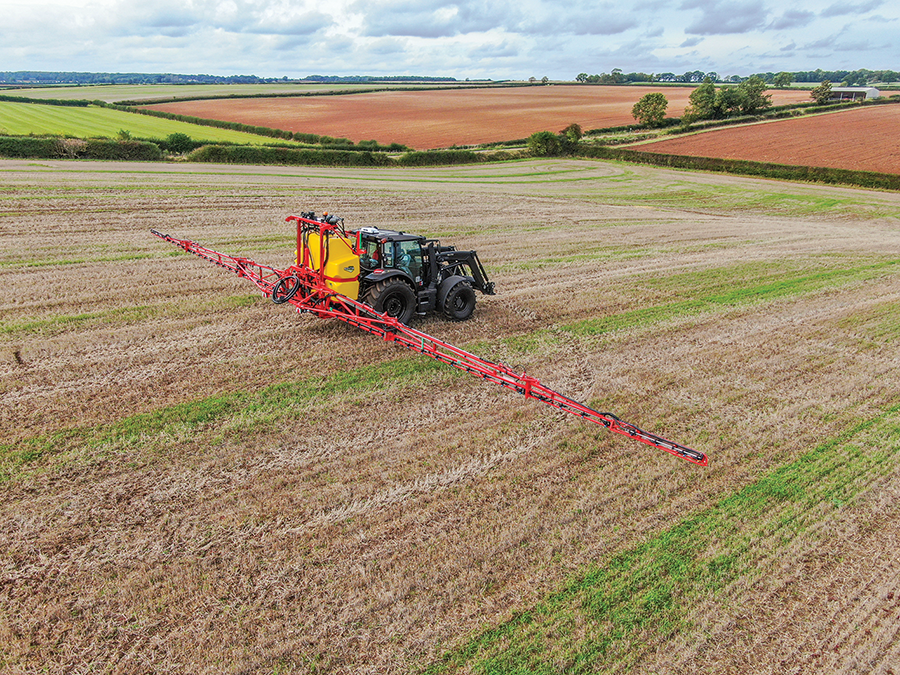
The Gecko PLK has a 1,500-litre tank and is available with side folding booms from 21–28m.
Proven brand
The new sprayers and cultivators are manufactured by Beyne which, like Knight, is a family-owned business. Beyne has manufactured sprayers since 1974, but the range hasn’t been available in the UK previously. Knight has history working with Beyne for several years already – supplying self-propelled skid units for Beyne to mount its own spraypacks. Working with Beyne means that Knight can remain fully dedicated to designing and manufacturing its own full technology larger sprayers at its factory at South Luffenham.
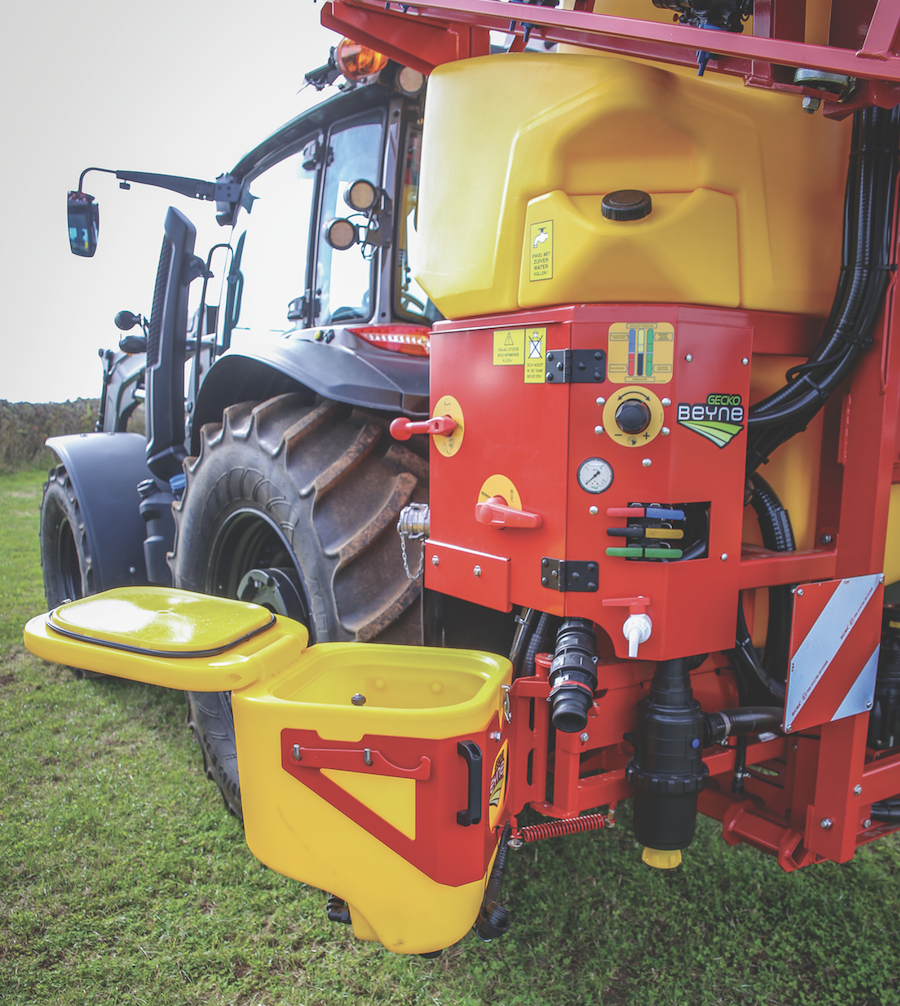
Knight’s Maximiser E-fluid control system is standard. The Gecko has a user-friendly chemical induction bowl and simple controls.
Range of specifications
The Red Line sprayer line-up includes mounted sprayers from 600–1,800 litres capacity and with boom widths of 12–28m. Larger models also incorporate Knight’s MAXImizer E fluid control system, which ensures efficient flow of liquid while keeping the plumbing to a minimum for fast response and a low volume of residual fluid.
The PA series includes models 600–1,000 litres with 12–18m manual folding booms, with control through a simple switch box for pressure and spray activation.
The higher-specification PLH models are from 600–1,000 litres and with 18–21m booms and feature hydraulic folding and more advanced controls.
Both series can be specified with pumps from 120–165 litres/min output.
Highest specification Gecko models include the PLK with a 1,500-litre tank and 21–28m side-folding booms, and the RF with an 1,800-litre tank comes with 18–28m rear-folding booms. The choice of pumps includes 174–255 litres of maximum flow. Basic controls are standard, but the specification includes Maximizer E fluid control. A Spraymat 2 controller, Isobus compatibility, auto height sensing and rate control are all upgrade options.
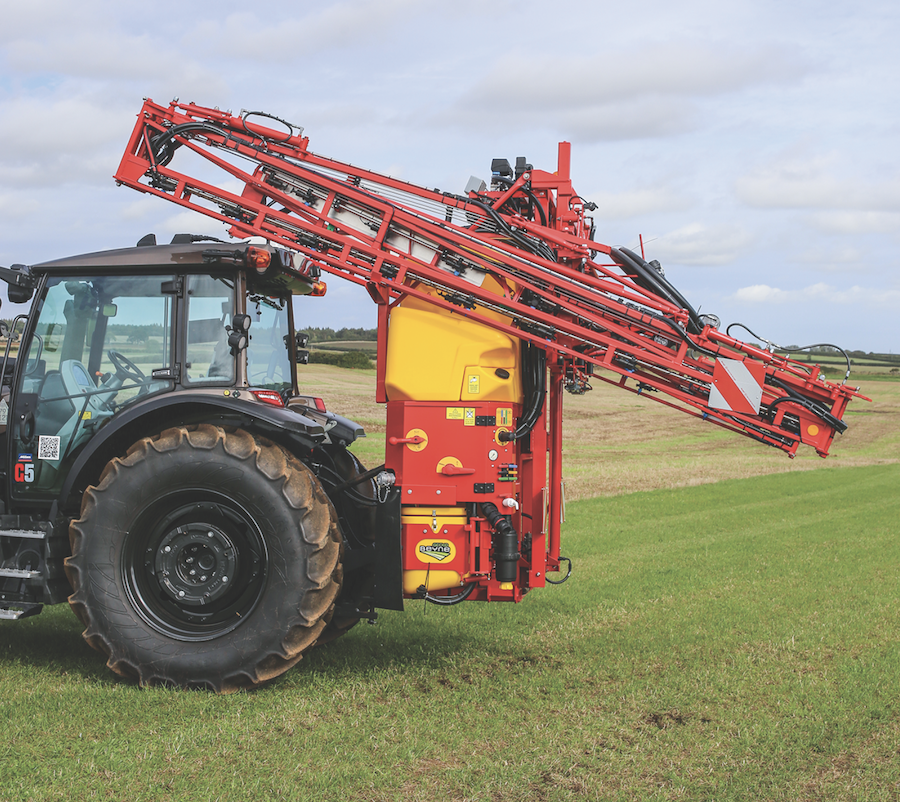
Hydraulic boom folding is standard on Gecko models.
Knight sprayer updates
Knight also announced updates to its own sprayer range at the event, including trailed models up to 12,000 litres capacity.
New Trailblazer 7000 and 8000 models with 7,000- and 8,000-litre, roto-moulded tanks come as standard with a single axle but can be supplied with a second air-suspended support axle to meet transport regulations – an option that will appeal to farmers travelling from the yard to the field with tanks filled with liquid fertiliser. Booms of 24–40m can be fitted, equipped with Knight’s 4D boom suspension system and spray section selection down to single nozzles.
Larger 10,000- and 12,000-litre models have stainless steel tanks and tandem axles as standard. The axle steering system has Muller controls. All models are Isobus-compatible. Additional new features include a lower boom park position to maximise stability for transport and a revised operating area around the induction bowl.
A new Maximizer Pro version of Knight’s Maximizer has been introduced. The Maximizer circulation technology includes a live induction hopper, booms supplied at multiple points to ensure even spray-line pressure, and continuous circulation of fluid through the complete boom supply system. Maximizer Pro brings additional efficiency benefits, including reducing boom pipework by 21% for even better spray-line circulation. Knight quotes a 7.5-litre reduction in retained spray fluid volume for its TB5200 trailed sprayer.
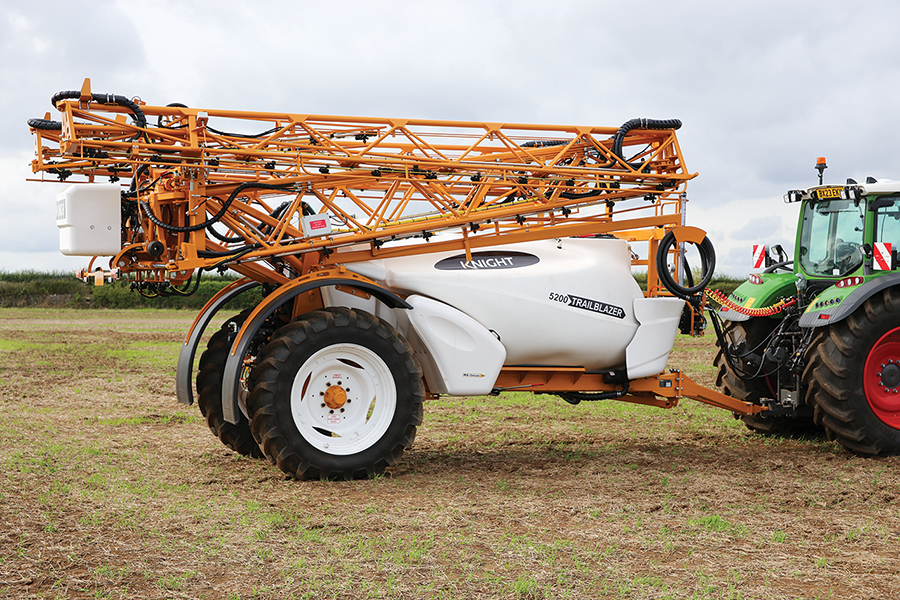
Knight also announced updates to its Trailblazer trailed sprayers, including new 7,000-/8,000-/10,000- and 12,000-litre models.
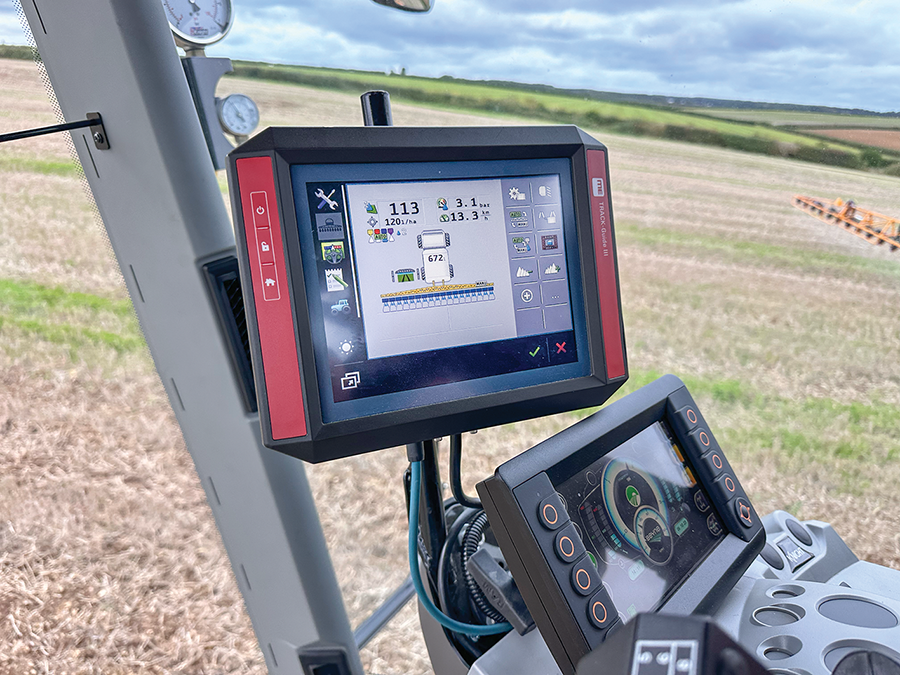
Vario-Select nozzle control which maintains optimum droplet size is a popular option. Curve Control is also increasingly specified for trailed and self-propelled sprayers with wider booms.
Maintaining accuracy
At the event, Knight demonstrated its Vario-Select and Curve Control application technology. Vario-Select uses a four-nozzle body to ensure optimal droplet size as application rates and travel speeds alter, in line with user-defined parameters. As the sprayer speeds up or slows down, then the system automatically switches to the most suitable nozzle or nozzle combination to maintain correct application rates without sacrificing droplet size.
Curve Control uses section control across the spray width to maintain the correct application rate during turns. On wider sprayers, the difference in travel speed across the ground between nozzles on the inside and outside of the turn is considerable. By dividing the boom into smaller sections and controlling the application rate of these individually, the system can maintain the correct rate for the sprayed area, avoiding under- or over-dosing. Knight said that although control by individual nozzle section is achievable, most users opt for 16–18 section control.
The typical four-nozzle combination fitted to the demonstration sprayer allowed application rates from 57–531 litres/ha to be achieved. Demonstrator John Wooding said that with the inner boom section travelling at only 5.7kph across the ground during tight turns, while the outer-most section achieved 53kph, the nozzle combination still maintained the correct rates.
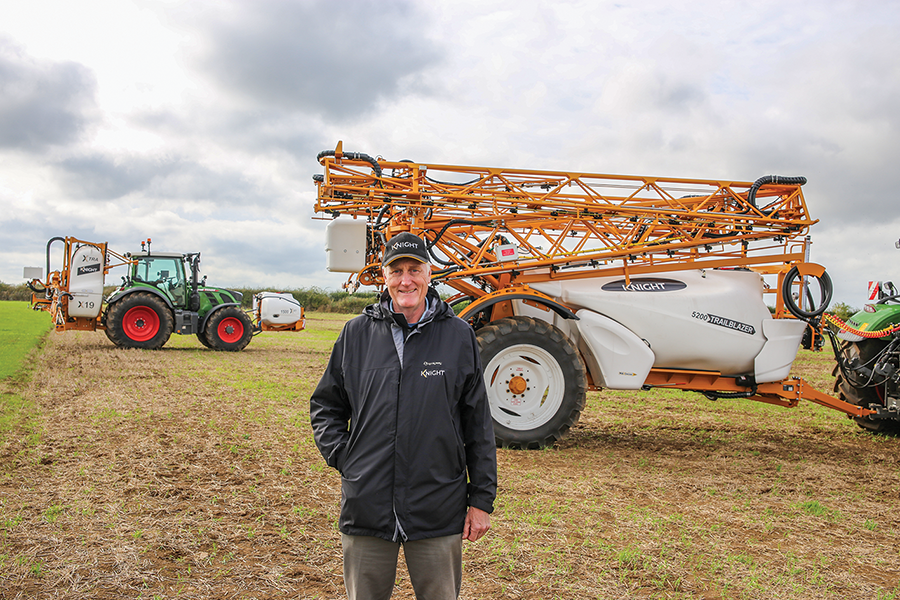
Brian Knight says that there is demand for the company’s rear, front and rear, trailed and self-propelled sprayers and that modern front and rear tank tractor-mounted combinations can replace ageing self-propelled sprayers of similar capacity.
Cultivator range extended
Complementing Knight’s proven Raven and Triple Press cultivators, Knight is offering Red Line power harrows and cultivators, built in Beyne’s factory in Austria – formerly home to Vogel and Noot.
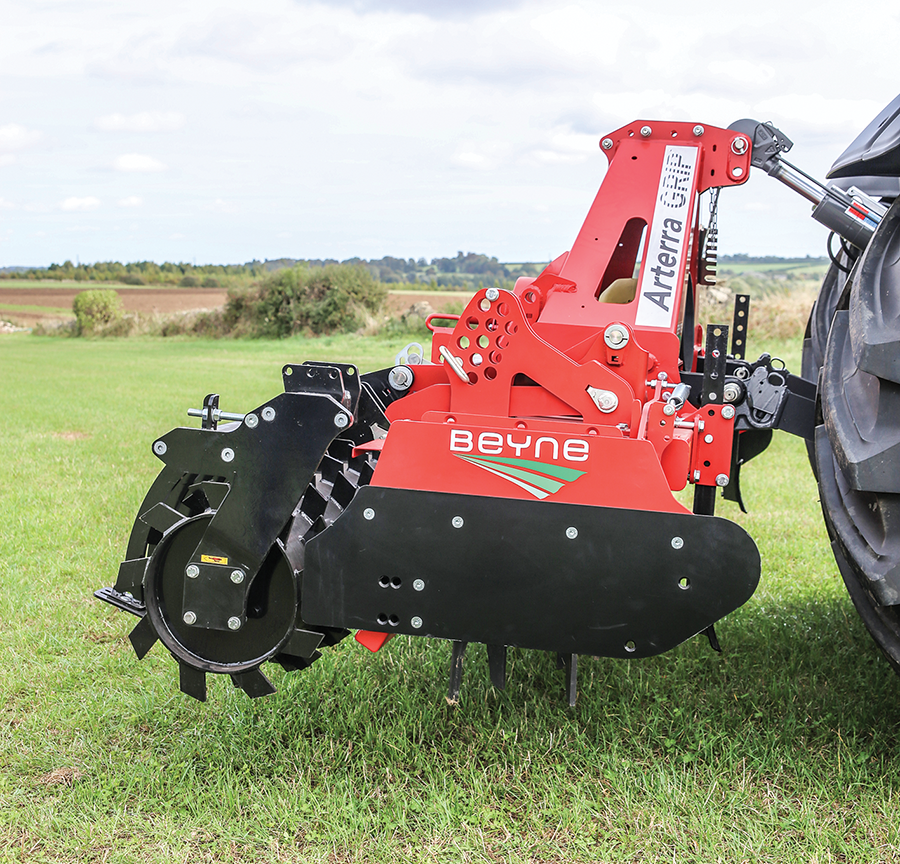
Red Line Arterra power harrows are available in a 3m working width.
Red Line power harrows
The power harrows come in two specification levels. Base MS variants – with 50mm rotor shafts are for tractors up to 180hp, while the premium MG models are rated for 230hp and have 60mm shafts. The power harrows come in a 3m working width, with 12 rotors and a double skin trough.
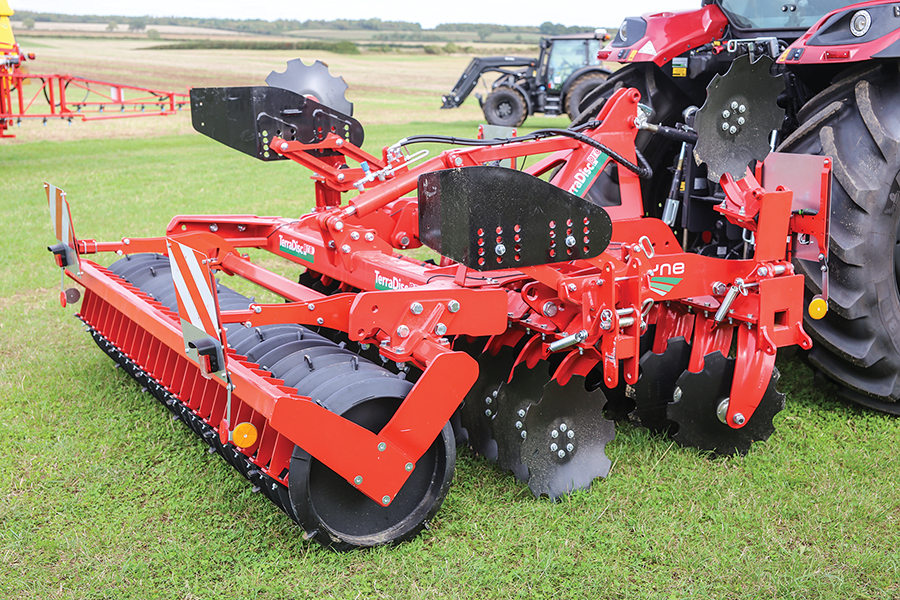
TerraDisc compact or close-coupled disc harrow cultivators come in mounted and trailed formats from 2.5- 6.0m.
Compact disc cultivators
Meeting growing demand for compact disc cultivators, Red Line TerraDisc models come in working widths of 2.5–4.0m in mounted format, and 4.0–6.0m trailed models. Discs are 510mm diameter standard (560mm is an option), run on SKF bearings and are rubber mounted. Working depth is set using integral aluminium spacers and there is a range of packer options. Mounted models have a 3m transport width – achieved by lifting and folding the outermost discs and side shields manually on both sides, while Pro trailed models have hydraulic folding. “Our 3m TerraDiscs are actually 3.2m wide in the working position, so that customers achieve the full 3m cultivation width they pay for,” said Paul. “This means that the outer working elements need folding for transport, but the process is quick and easy.”
Offering choice
Knight managing director, Brian Knight told Farmers Guide that demand for the company’s self-propelled sprayers remains very strong, but that there is growing demand for tractor-mounted sprayers with front and rear tanks, including from farms wanting to replace ageing self-propelled machines. “For operating on steep ground then the weight distribution achieved by the combination is ideal and a 4wd tractor will travel almost anywhere. Many modern tractors already have auto-steer and GPS field management which means there is no need to pay for duplicate systems on a new self-propelled sprayer. Our mounted sprayers are available with the same high level of application technology as self-propelled or trailed models, and latest models with a front tank offer capacity equivalent to or more than self-propelled machines in the past, so they can make a lot of sense where investment in a new self-propelled machine can’t be justified.
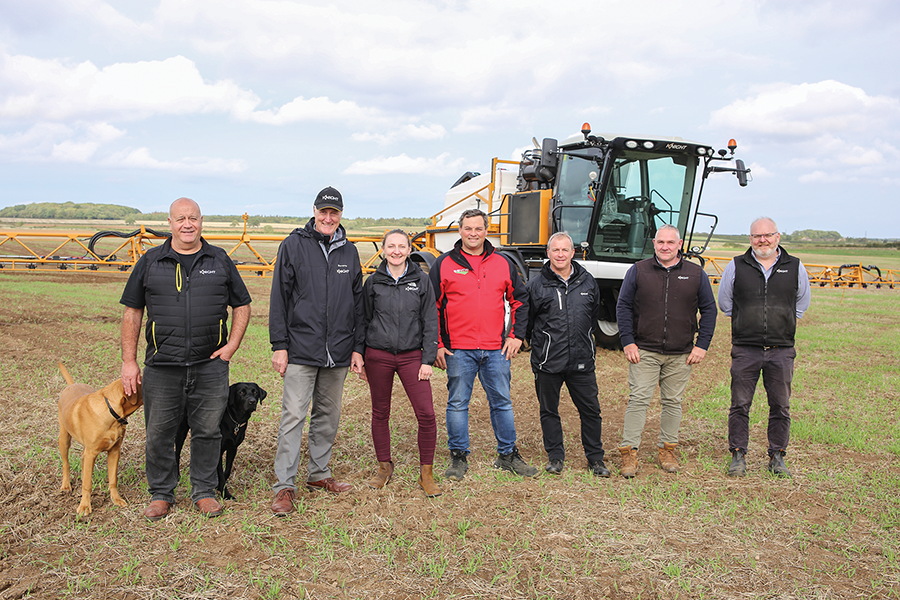
Members of the Knight team at the event (l-r) Paul Harrison with his dogs Paddy and Murphy; Brian Knight; Clare Slane; Beyne technical and sales director, Steve Vierstraete; Cliff Buck; John Wooding; and Darren Bentley.
“The Beyne products complement the durability and build quality of Knight sprayers we manufacture in the UK, but we do have a price premium due to the level of technology. It’s all about what is right for the customer, so we provide the range of options,” he confirmed.
Brian’s daughter, Knight director and service manager Clare Slane said that Knight sprayers have earned an excellent reputation. “They just never seem to wear out,” she explained. “Users love them, and many units 20 years of age are still reliable and performing well. But we make the most of this when machines are traded in by selling the sprayers again fully reconditioned and checked and fit to continue working.”
From the steel and fuel-saving potential of variable tillage to the enhanced establishment and yield prospects for more accurately-drilled crops, the focus of many of Vaderstad’s product developments unveiled at its autumn European product launch in Austria was on precision.
Varying tillage depth on the move
To this end, Vaderstad reckons its variable-depth cultivation development for its TopDown and Opus cultivators may be an option in which some purchasers on variable soil types could find significant return.
The system uses the firm’s E-Control software in conjunction with prescription maps based on factors such as soil sampling or type maps. This information is used to automatically raise and lower elements of the machine as required.
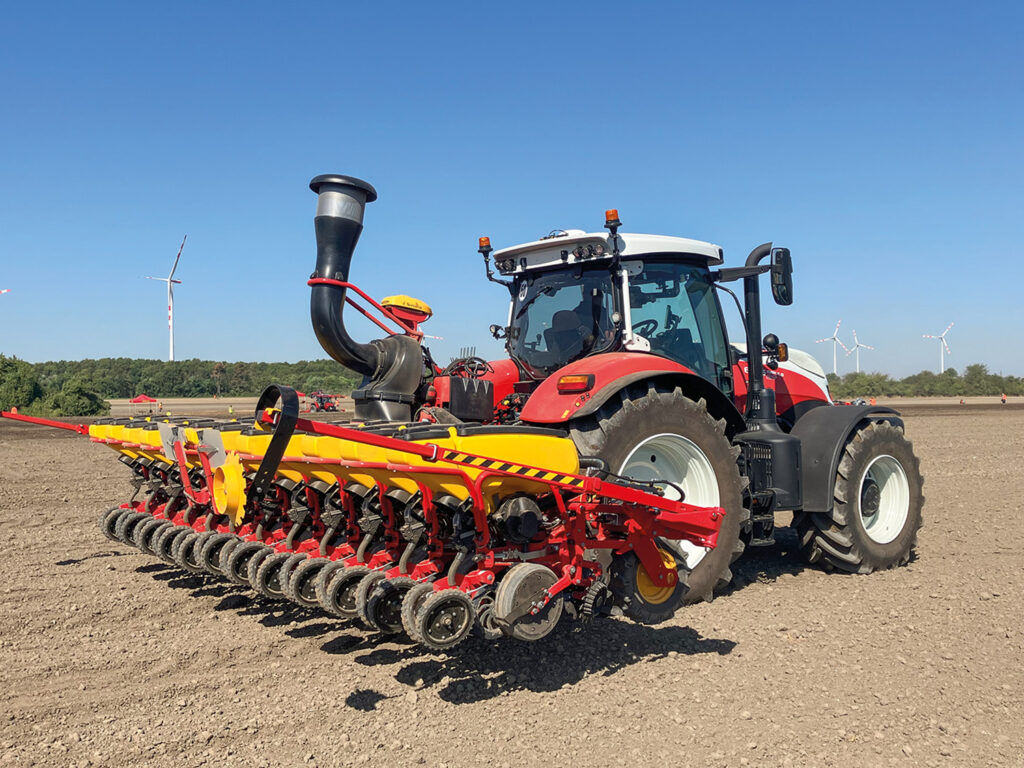
Vaderstad’s Tempo F, Tempo V and Tempo L precision drills now all feature new WSX electronic management with automated singulation, plus active hydraulic downforce.
The company believes this is the next step on from variable rate seed and fertiliser application, and that by moving soil as much as necessary but as little as possible, there is potential for significant benefits in terms of fuel use, steel wear, time, soil structure, moisture, carbon retention and workrates.
“Using E-Control, individual working depth or intensity of the discs, tines, levelling elements and packer can be set and altered before and during work, with four pre-sets available to store different machine configurations for different jobs or known areas,” said Vaderstad UK regional sales manager for the north, Ed Hutchinson.
“Adapting working depth to a yield map can also help incorporate residues more evenly and effectively, and that can bring benefits for the emergence of the following crop, which should be further helped by the enhanced slug control this also brings.
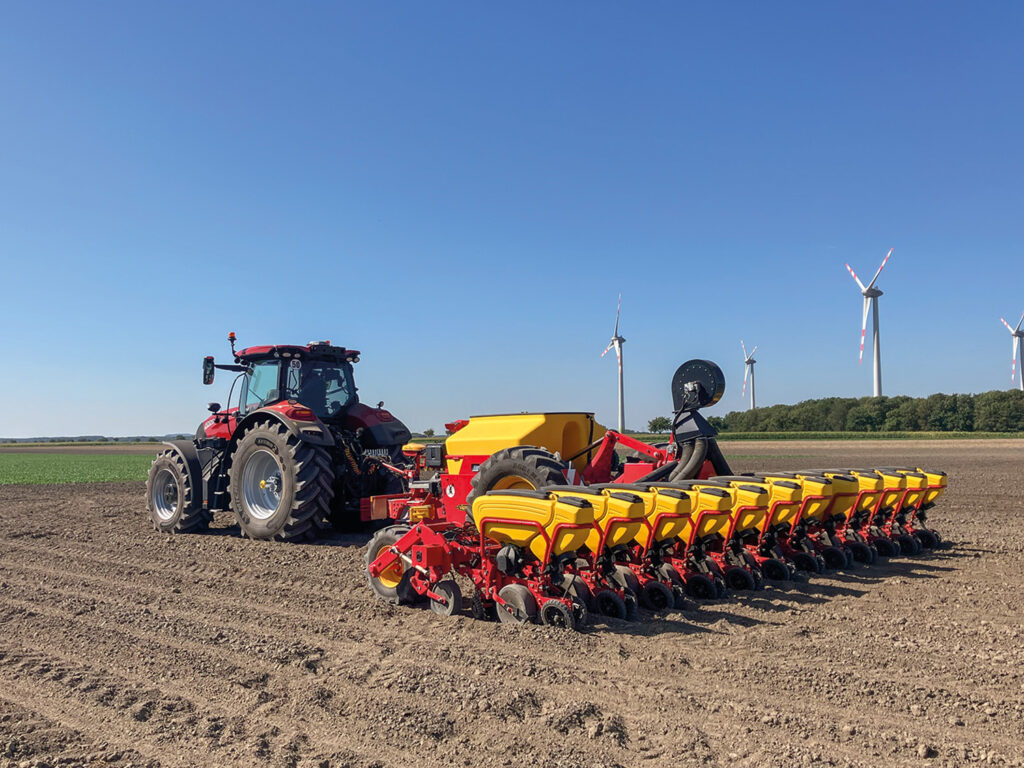
Tempo L 824 row precision drills are now available with a liquid fertiliser kit, incorporating a 2,000-litre tank.
“Reconsolidation pressure can be automatically related to working depth, soil type and moisture content, which also aids following crop emergence. With the introduction of E-Services on TopDown and Opus, these machines are fully able to use prescription maps, for on-the-go automatic machine adjustment. Using the iPad-based control E-Control, individual element working depths and the intensity of the discs, tines, levellers or packer can be manually or automatically adjusted while on the move.”
Planting with greater precision
From its precision planters to its combinable crop drills, Vaderstad also has a number of seeding developments in store for 2024. On the precision drill front there is the introduction of a liquid fertiliser kit option for the Tempo L 8–24 precision drill models.
“It’s something that, internationally, is likely to be of greatest interest to farmers in eastern Europe where the springs are late and cold, and crops such as maize and sunflowers need the best possible start,” said Vaderstad UK market development manager, Andy Gamble.
“But we may see interest from farmers in the north of the UK looking to give an early boost to crops such as maize.”
Created to be a fully integral element of the Tempo L design, at the heart of the fertiliser kit is a 2,000-litre tank. The operator enters the required application rate into the control software. Flow sensors then continuously monitor and maintain it once the machine is at work, meaning there is no need for a calibration process. On 75cm-spaced rows, rates from 30–200-litres/ha can be applied at up to 15kph without changing nozzles.
Filling equipment can be specified according to the customer’s requirements, with the possibility to fill the tank via gravity feed, an external pump or the fertiliser system’s integrated pump. Like the drill itself, the fertiliser equipment is managed through Vaderstad’s iPad-based E-Control, with filling a simple matter of the operator entering the required intake amount. Application can be in the seed row via the seed units or beside the seed row via fertiliser coulters, and as with the drill’s seed distribution, the liquid fertiliser is automatically shut off row by row on angular work.
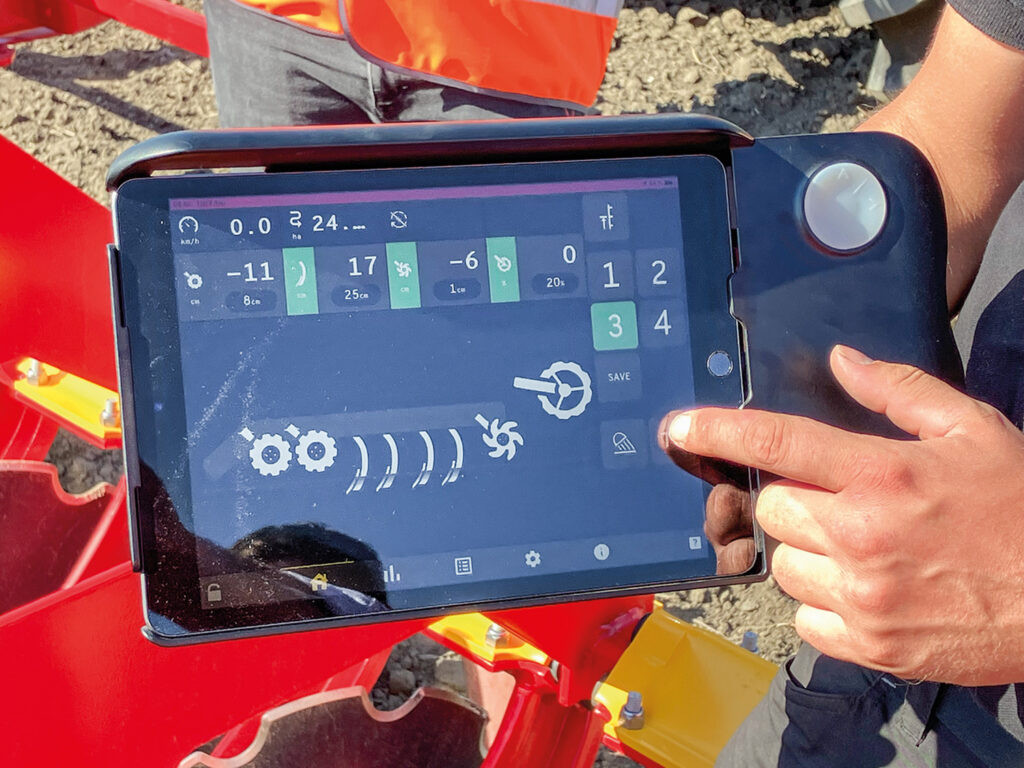
The Opus/TopDown variable-depth cultivation option uses the iPad-based E-Control for pre-work setting of individual element working depths, which then vary according to mapping.
There are also some further changes for the full range of Tempo F, Tempo V and Tempo L precision drills, which now all incorporate new WSX electronic management. The key advantage here, says Vaderstad, is that there is no need for any sort of manual setting for the singulation. Sensors in each row unit continuously monitor the singulation process, and make adjustments automatically as necessary. The company suggests the upgrade will be especially beneficial to farmers and contractors drilling a range of different crops across the season.
With an active hydraulic downforce system, optimal row unit pressure can be set and then automatically maintained to ensure consistent planting depth regardless of variations in soil type or compaction. WSX also provides curve compensation, ensuring consistent metering and accuracy during turns. Information from gyroscope-based sensors prompt adjustment of each row unit’s metering to ensure rate consistency across the planter width.
Seed Hawk developments
Vaderstad has enjoyed success in the traditional North American large trailed no-till drill market for the past 10 years since acquiring Canadian manufacturer Seed Hawk, but the European market has proved a little harder to crack. To address this, the firm has now developed a new range of its Seed Hawk no-till drills designed to more closely match European needs.
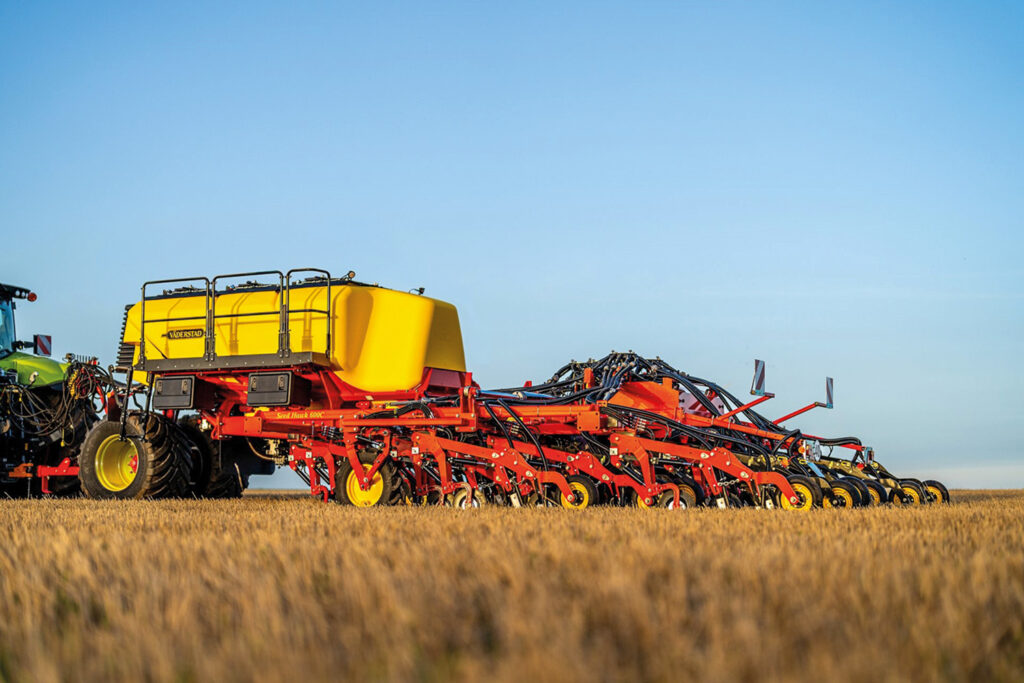
New 6–9m Seed Hawk 600–900C models engineered for Europe feature new front discs for trash/cover crop processing, and knife coulter openers.
The 6–9m Seed Hawk 600–900C models feature a new front disc option for trash/cover crop processing, and knife coulter openers designed particularly for European soils, with a dual knife system where the second knife covers the fertiliser with soil before the seed is placed, to prevent seed scorch. Up to three compartments can be specified in the seed hopper for seed, fertiliser and cover crop application, while the Fenix III metering and other functions are controlled by the iPad-based E-Control system. Operation is also via the iPad-based E-Control system.
Elsewhere on the seeding front, final design and detail for Vaderstad’s Proceed precision all-crop drill is expected at November’s Agritechnica. Said to be suited to working with cereals, oilseed rape, sugar and fodder beet, peas, maize and sunflowers, the company claims that trials in wheat suggest more consistent seed placing, so that seed rates can be halved without impacting yield. The Proceed has been tested in Sweden, the UK, France and Germany over the past four years. Post-seeding trials in winter wheat, at a seed rate of 150 seeds/m2, showed an increase of 102% in plant biomass, 72% in root biomass and 62% more shoots per plant when compared with a standard cultivator drill.
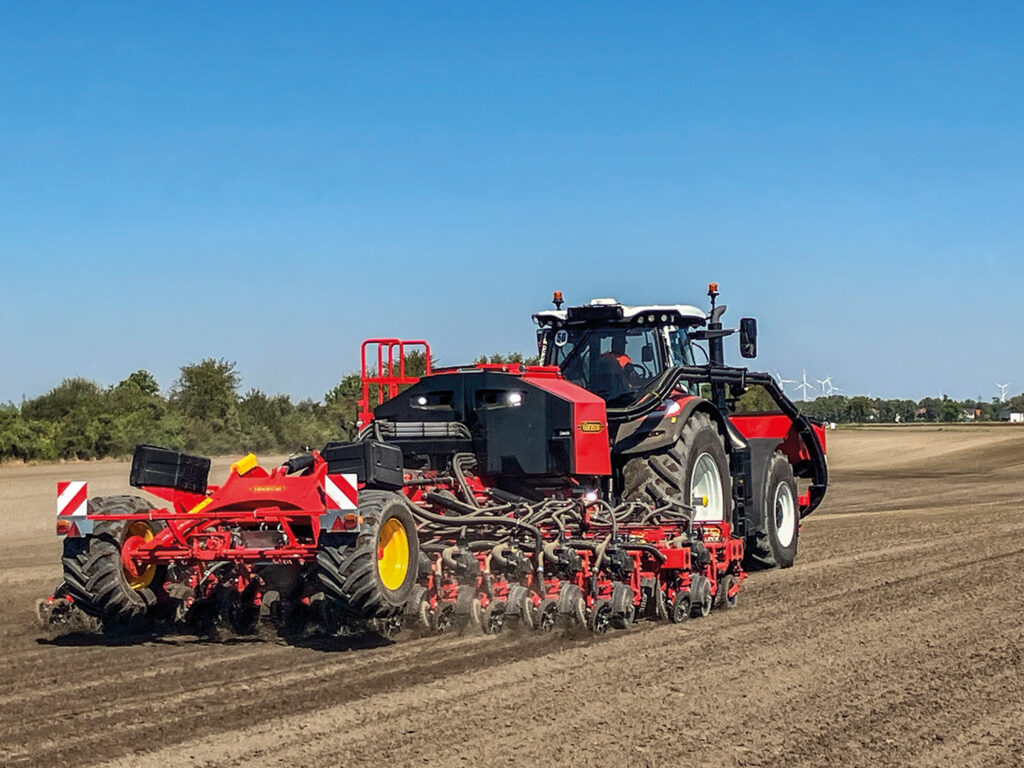
Further news on the final design details and specification for the all-crop Proceed precision drill is expected at Agritechnica in November.
Suited to drilling on ploughed ground, in min-till situations, into cover crops or direct into unmoved land, the drill’s two rows of seeding units can sow cereals at 22.5cm or 25cm spacing, 45 or 50cm for oilseed rape or sugar/fodder beet, or 75cm for maize.
Press wheels ahead of each row unit bear the machine’s weight as well as providing pre-consolidation for the coulters. The 3,000-litre seed hopper can be complemented with a front-mounted fertiliser hopper. Seed metering is via a modified version of Vaderstad’s PowerShot singulation system, with each seed leaving the short seed tube then being received by a stop wheel to ensure the selected depth is achieved across the full working width. Each row is electronically-governed, driven and controlled using the iPad-based E-Control application, with functionality including individual and sequential row shut-off, variable rate application, dynamic tramlining and individual calibration, while also offering full monitoring and control.
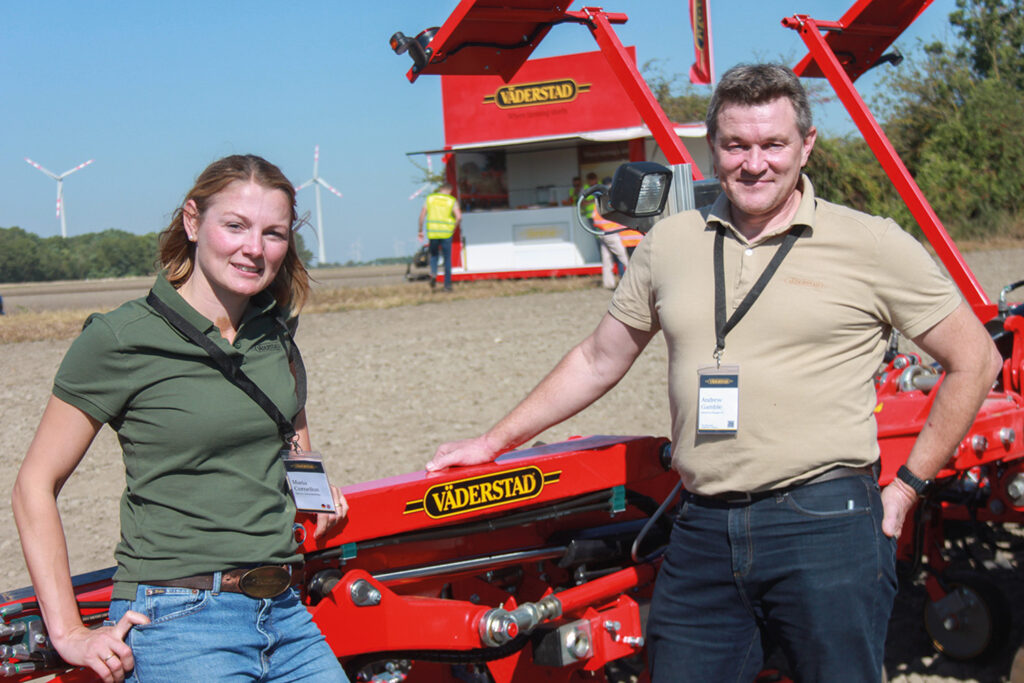
Vaderstad director of marketing, Maria Cornelius, with UK sales and marketing manager, Andy Gamble.
A new market: Mechanical weed control
Meanwhile, Vaderstad is also entering the rapidly-developing market for mechanical weed control in row crops. The company’s new Extract line of inter-row cultivators is available in two ranges: the trailed Extract L, with 16–48 rows, and the 8–26 row Extract V mounted machines. Design features include maximum ground clearance of 85cm, which Vaderstad says enables a longer, later weeding season as crops grow taller. A section lift function is guided by GPS coverage mapping to raise individual row units to 75cm above ground and prevent crop damage at headlands and in short work.
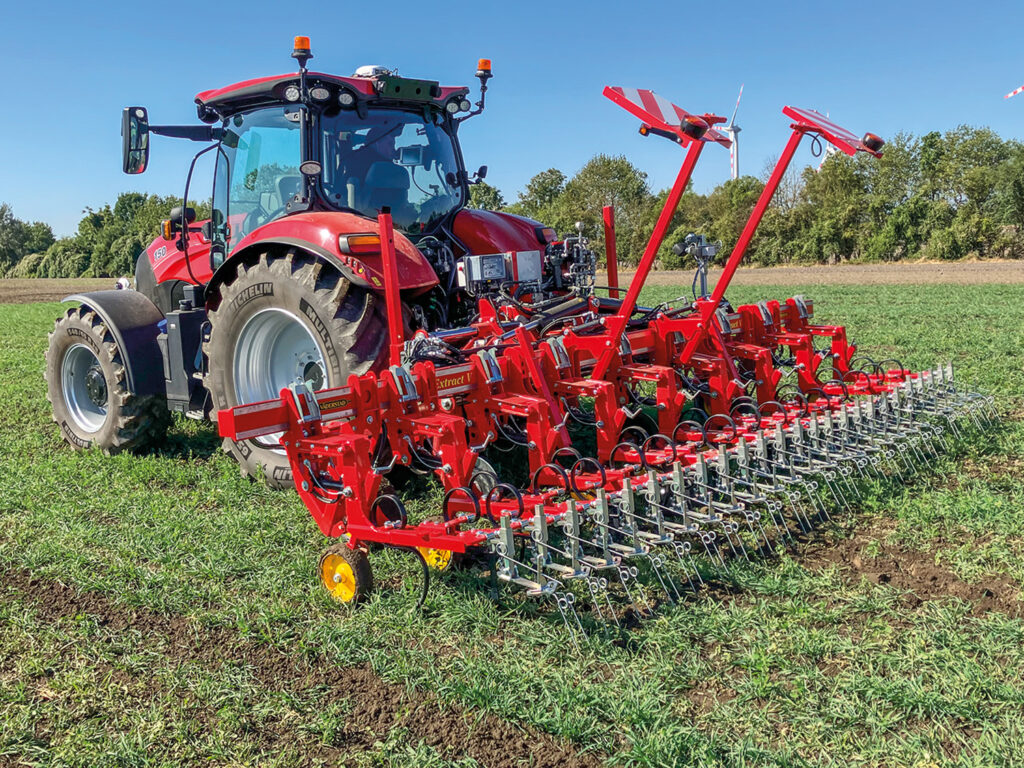
Vaderstad’s new Extract line of inter-row cultivators is available in two ranges: the trailed Extract L, with 16–48 rows, and the 8–26 row Extract V mounted machines.
The machines are available with 3D camera guidance to maintain in-row accuracy by monitoring three plant rows, meaning cultivation is possible as close as 3.0cm to the plants in each row. For weeding established crops like maize in early summer, a mechanical row steering option is available.
The company offers the renowned line of Simtech direct drills with its proven T-slot tines.
The drills are relatively simple, well-built, reliable and cost-effective, with minimal moving/wearing parts. These versatile machines will penetrate even very hard ground, while the renowned T-slot system creates a unique environment for the perfect seedling germination, even in the most demanding conditions. The drill range extends from 2.4m grass drills up to 6m folding arable drills.
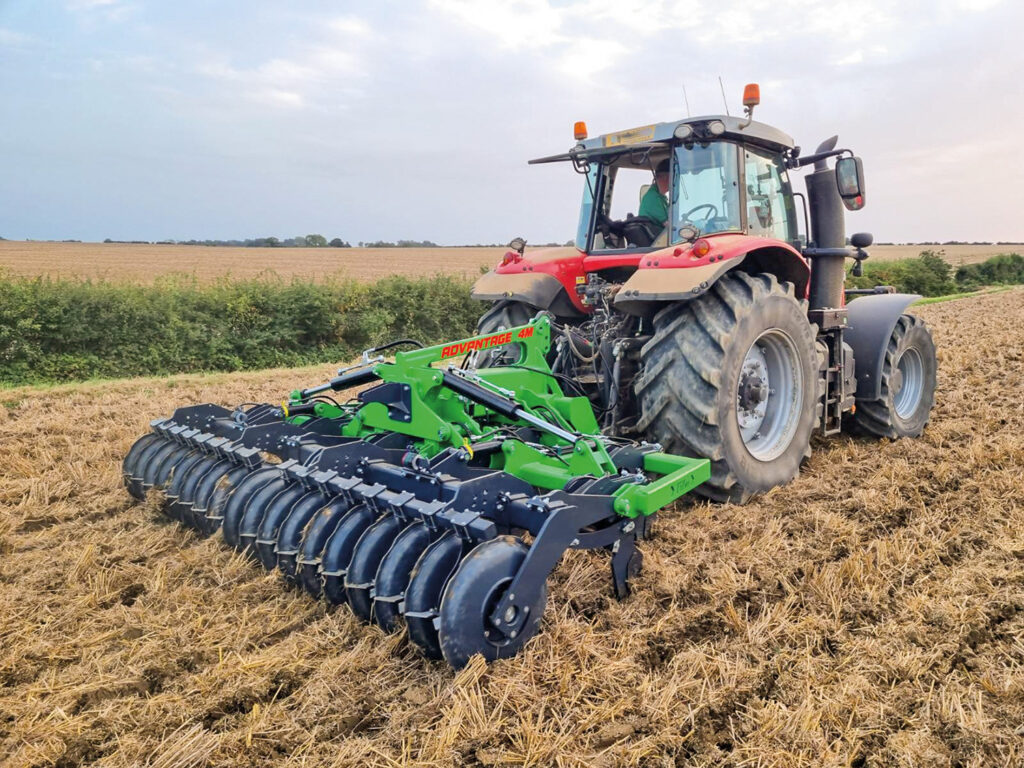
Some of the new releases planned for 2024 include:
- New front-mounted hopper models to allow wider drilling using less horsepower and more balanced loading of the tractor
- A four-toolbar frame for users with high trash conditions or application into cover crops
- A trailed kit as an intermediate step from a fully mounted machine to a trailed machine
- A lightweight folding drill with no rear spring flex roller.
The company also offers ultra-low disturbance subsoiling products using Tillso tine technology, shallow annual or bi-annual restructuring by lifting and dropping the soil over a wing to create vertical fissures for better root establishment. The tine has been developed to create minimal surface disturbance, this reduces the need for following cultivations, prevents weed seeds from being dropped throughout the soil profile and keeps fine soil particles on the surface. The ‘Advantage’ is offered from 3–6m, in both mounted and trailed formats with various optional extras.
Another key tool in the shed is the ‘Commander’ – a shallow tine cultivator which promotes the production of stale seedbeds. The machine is offered in 6, 8, 10 and 12m widths, with optional vertical tillage discs.
The business model revolves around soil health and reduction of inputs. The aim is to achieve maximum yields without high input costs, while at the same time, improving the soils for the future.
The event opened with an address by Lemken company owner and board member, Nicola Lemken who is the seventh generation of the Lemken family to own and run the 243-year-old business.
Lemken CEO, Anthony van der Ley talked about recent sales performance and confirmed that the results for 2023 appear extremely positive, although his expectations for 2024 are for reduced sales due to European-wide higher interest rates.
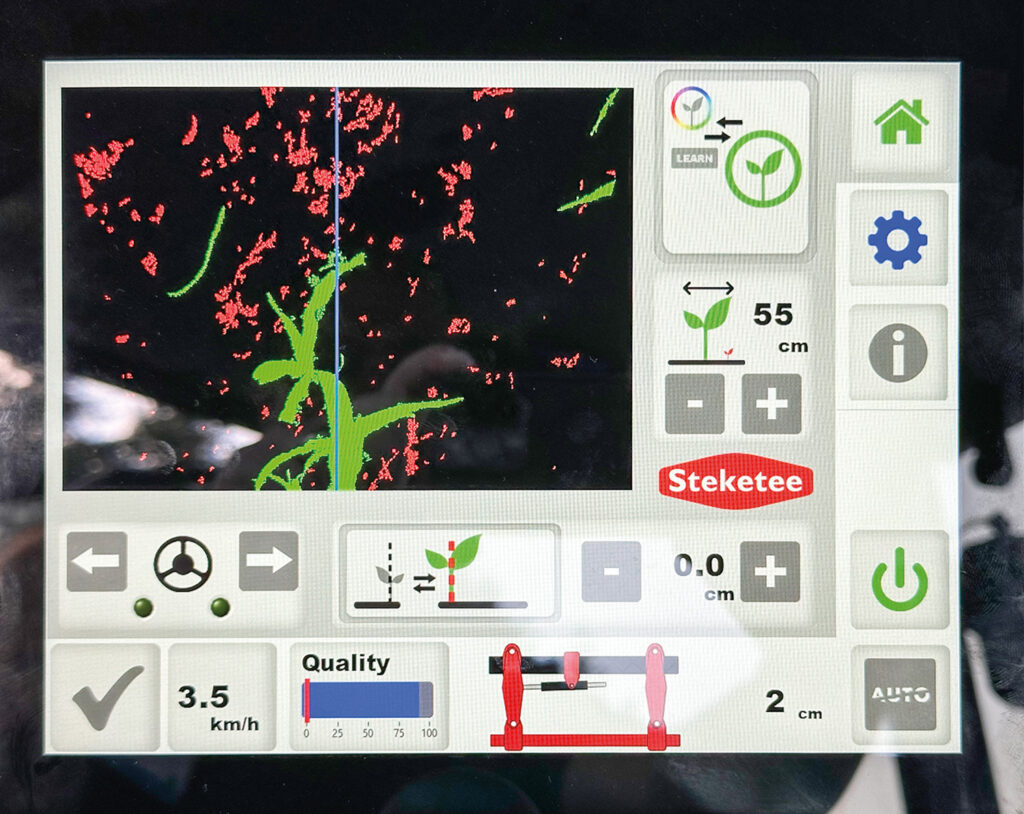
Continued investment into products offering even better mechanical weed control includes plant-type recognition by camera using AI. Lemken has a solution for sugar beet growers, capable of recognising the crop from the two-leaf stage.
Investment in weeders
Lemken acquired mechanical weeding machinery specialist, Steketee in autumn 2018. Since the acquisition, Steketee production and sales volumes have tripled, to the extent that the current factory in the Netherlands has been outgrown. In spring 2024, machine production will transfer to a brand-new factory. The 5ha site will accommodate a 10,000m2 production area as well as an Agrofarm where products can be tested and demonstrated. The current manufacturer team of 60 staff will be doubled.
Until now, Steketee products have continued carrying their traditional branding including bright red paint, but from early next year the Lemken name and blue colour will be used instead. “The Steketee name is associated with expertise in this product area, but the Lemken name and colour is better known worldwide, so it makes sense to use these going forward, suggested Anthony. “Our target is to develop 20–25 new markets for the range throughout Europe and overseas.”
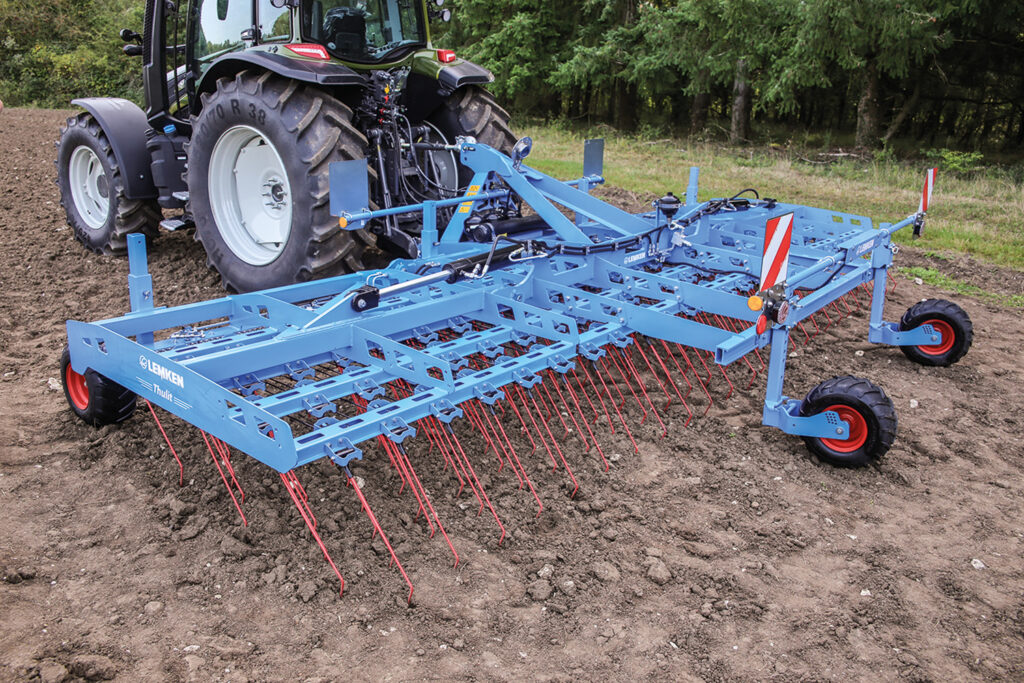
The new Thulit weed harrow is described as ‘third-generation’ by Lemken, for its ability to accurately maintain working pressure and depth even across undulating surfaces such as potato ridges. A 12m version will be available in 2025.
Continued investment
Recent developments in the Steketee product line-up includes new camera guidance technology combined with AI for increased suitability in a wider range of crops.
The IC Weeder which removes weeds using pivoting blades is expected to have strong appeal for sugar beet growers as improvements for 2024 will include plant recognition from just two true leaves, whereas current systems recognise the crop only from the four-leaf stage when hoe weed removal treatments are often too late. Lemken says the improved crop recognition capability allows 20% faster operating speed, and crop recognition accuracy of 95%.
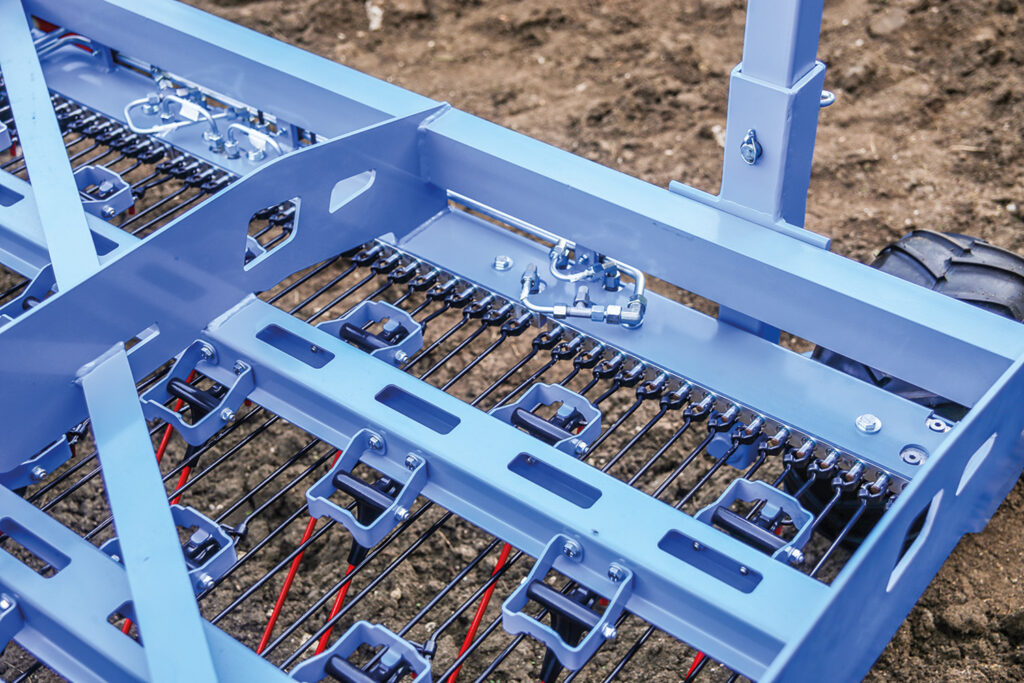
Each Thulit tine is independently mounted on a durable plastic pivot, and working pressure is maintained using miniature hydraulic rams (one for every tine) within the implement frame.
Third-generation harrow
The Thulit spring harrow weeder is completely new. It consists of a bank of close-spaced sprung rake tines and its unique design ensures consistent operating pressure across all the tines regardless of whether some are working on top of ridges while others are in a furrow. This results in effective weed removal across the full working width, even on uneven ground. An adjustable tine angle allows operators to achieve the amount of aggression required. The tines are individually mounted on hinged brackets and connected by tension rods to separate miniature hydraulic rams. An accumulator helps maintain equal hydraulic pressure across the bank of cylinders, regardless of the number of tines in the raised or lowered positions. Lemken argues that the hydraulic pressure control system is simpler and more effective than complex spring arrangements.
The harrow operates by pulling small weeds out of the ground leaving roots exposed on the surface to dry out while other weeds are covered in soil preventing light interception. The spring rake tines aerate soils and break the top crust allowing moisture to penetrate while also levelling the surface.
The harrow is suitable for row crops, vegetables and ridged crops such as potatoes, and it is described by Lemken as a third generation weed hoe, because of its advanced design and ability to achieve the same operating pressure across all the tines no matter how uneven the ground.
The overall tine spacing is 31.25mm equivalent to 32 tines per metre. Lemken explained that mounting the tines across four rows allows large clearance between the tines within each row for trash and plants to flow through easily while achieving up to 97% effective weed control at a working speed of 8kph. Generous underbody clearance beneath the frame means blocking the harrow is almost impossible.
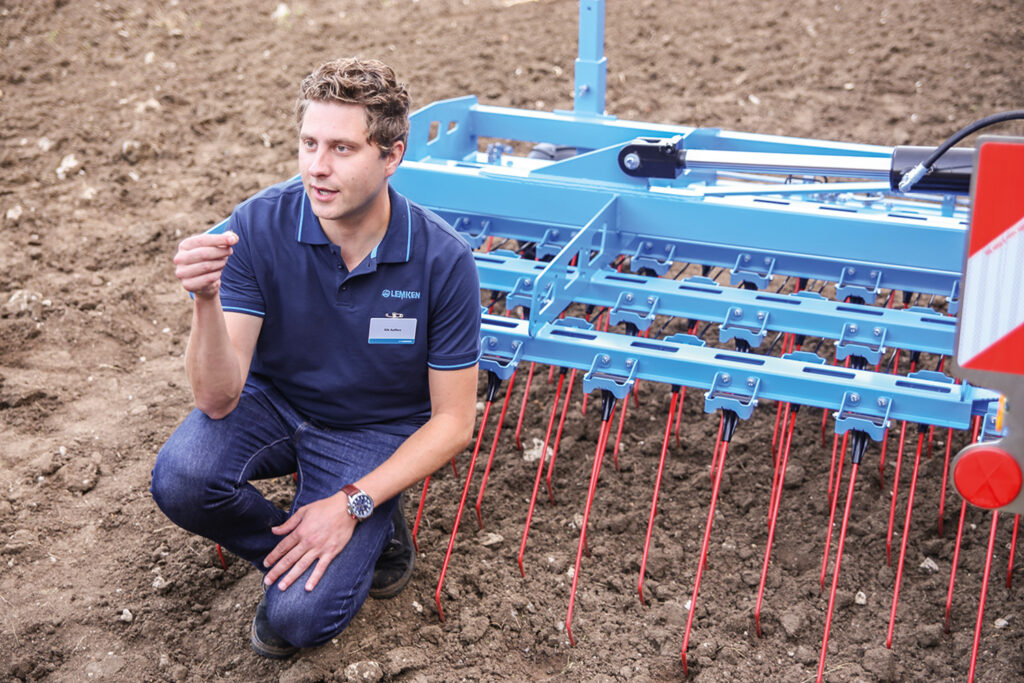
Thulit product specialist, Rik Aelfers is pictured with the new harrow, explaining that the very best weed control is achieved by tackling weeds as early as possible.
Simple set up
Two wheels front and rear control the working depth and the tine operating pressure is set hydraulically. Working pressure for each tine can be adjusted between 100–5,000g. When the working pressure is released, then the tines retract up into the frame achieving a narrower folded width for transport.
Only 50 of the Thulit 6 and 9m rakes will be available for next spring, and a 12m version will be launched in 2025 and is expected to eventually account for most sales.
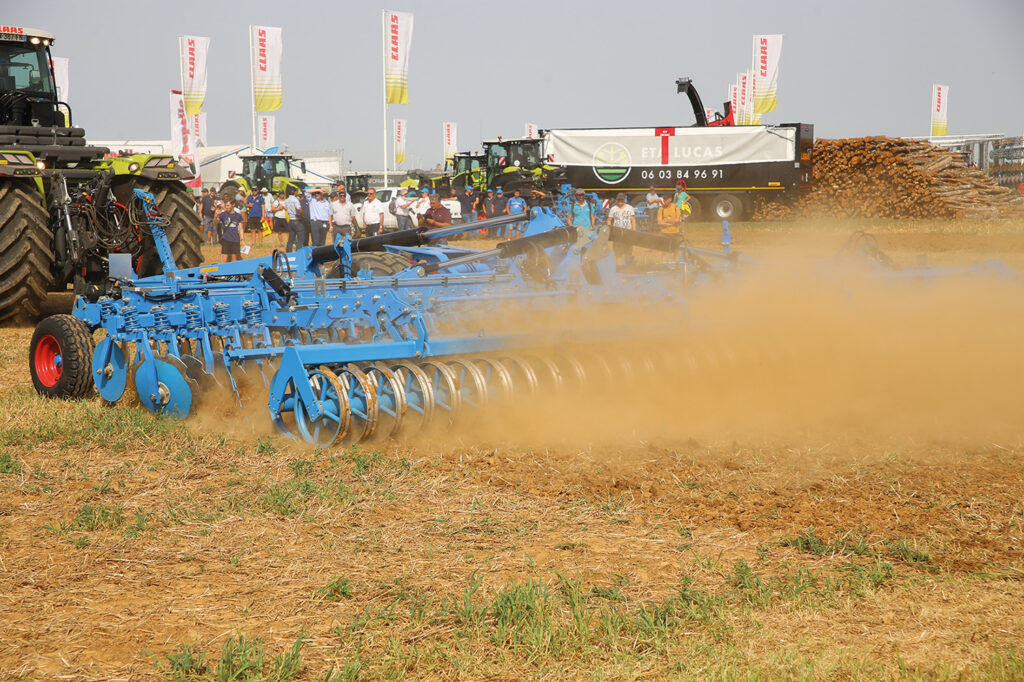
The new Rubin 10, 10m compact disc harrow was demonstrated for the first time at the event.
New Rubin 10
During the press event, Lemken also demonstrated its brand-new Rubin 10 10m heavy disc cultivator for the first time in Europe, just a few days after its first public viewing at a show in the USA.
The new compact discs are the widest single units from Lemken so far, as achieving this width previously was only possible using two smaller sets mounted side-by-side on the Gigant tool carrier.
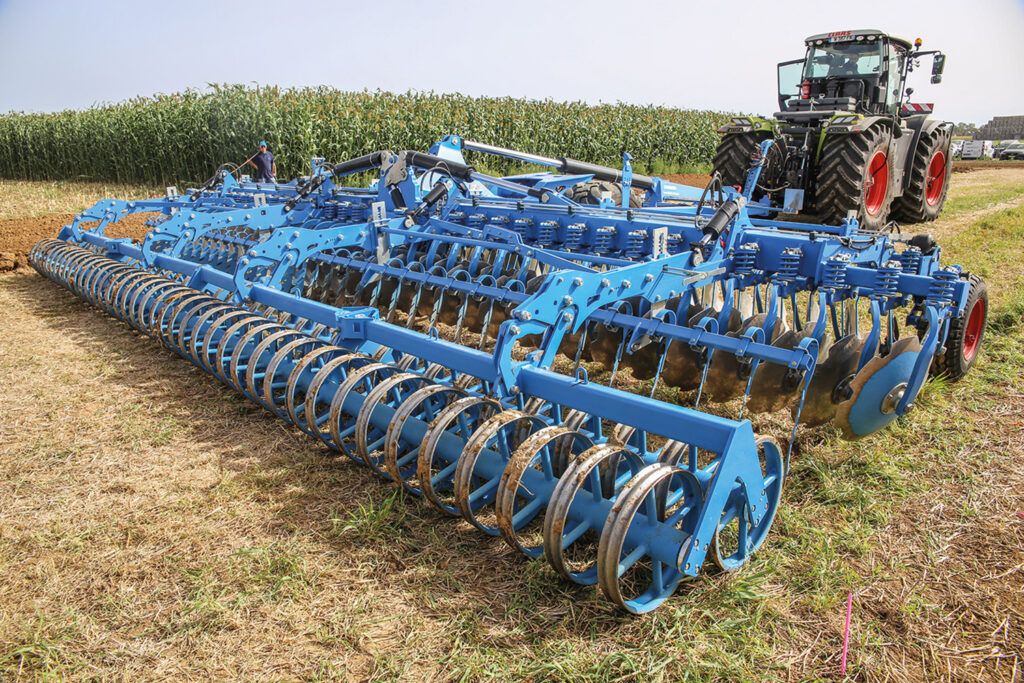
The 10m discs achieve high work rates while maintaining excellent ground contour following.
Effective results
The Rubin 10 has 645mm discs and, like smaller versions of the Rubin 10, these are arranged symmetrically to ensure a straight pull for fuel-efficient operation. The serrated concave discs are in two rows and ensure effective mixing and incorporation at shallow working depths down to only 7cm. The discs have an overall 14cm line spacing providing plenty of clearance for trash to follow through and each disc has individual overload compensation, with dampers reducing kick-back and preventing potential damage to the frame.
Hydraulic adjustment allows the working depth to be altered on the move from the cab.
The levelling tines are conveniently adjusted by hand from outside the implement frame ensuring maximum safety. The rear packer features new heavy-duty bearings designed to withstand the heavy working loads including carrying the discs when turning on headlands, and the discs are Lemken Duramaxx faced and 6mm thick for a long working life.
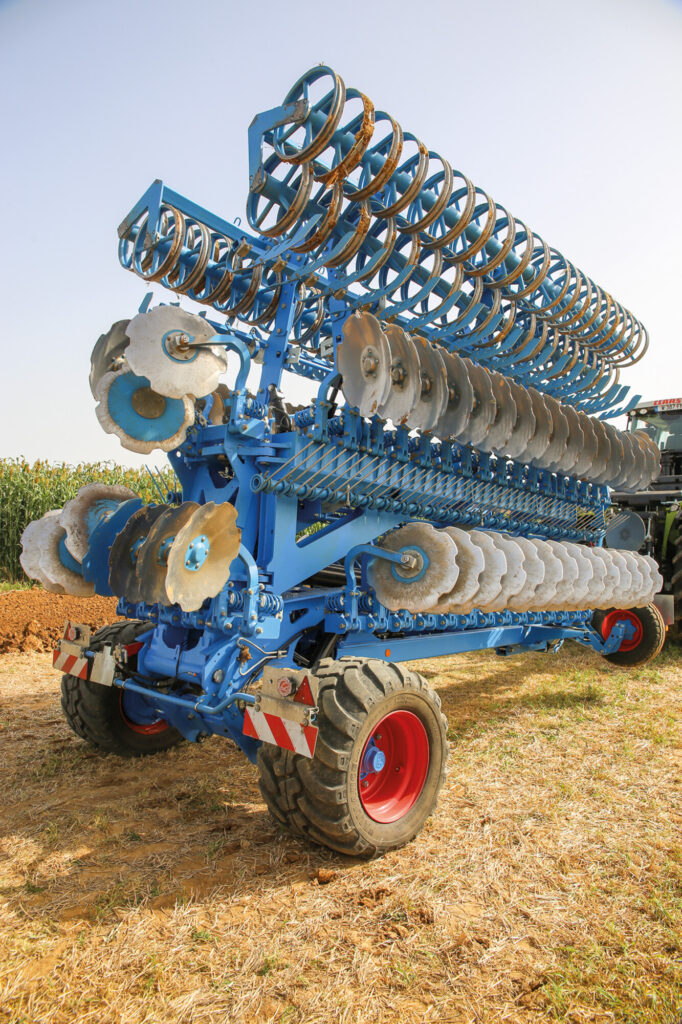
The discs fold to less than 3m wide, under 4m high and can be towed at speeds of up to 40kph.
Contour following
iQ-Contour pendulum-type suspension utilises an articulated chassis which allows the front and rear sections to move vertically. Up to 4.5 degrees of vertical downward movement and up to 6.0 degrees upward movement maintains excellent ground contour following, even across severe ground undulations.
Towing is by a drawbar eye or ball coupling and a hydraulic support ensures easy attachment to the tractor, while the hydraulic operated rear packer makes it easy to reverse the heavy discs into field corners and work around obstructions.
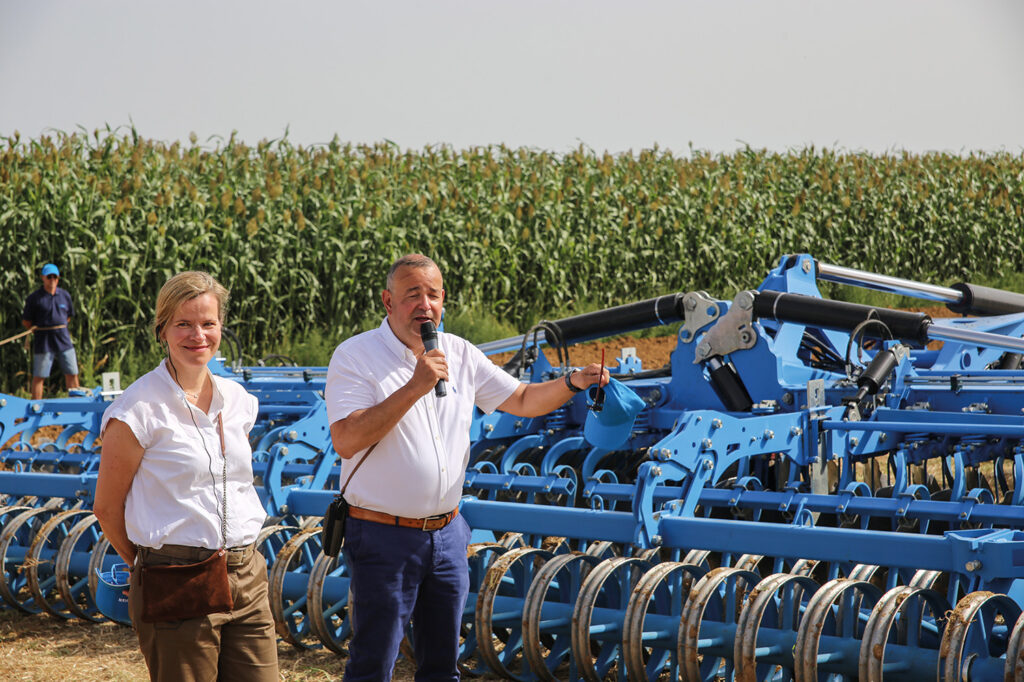
Nichola Lemken is pictured with Lemken CEO Anthony van der Ley at the first demonstration of the new 10m Rubin 10.
Deliveries for next autumn
Lemken said at the event that the Rubin 10 10m discs are the widest 645mm discs currently available and that they are designed for use with tractors from 350–500hp. The main design advantages include accurate depth control and ground contour following as well as exceptional convenience for transport, as the set folds to under 3m width and 4m high and is approved for towing at speeds up to 40kph.
Deliveries commence in time for next autumn cultivations and the price is approximately €170,000.
Look out for original tinwork
“Enthusiasts like tractors with genuine tinwork, in good condition; originality is very important – if I had to choose, I would rather buy something with good tinwork even if the engine doesn’t run. But I would rather a good engine if the tractor has rotted and rusted through, or the tinwork is missing – although reproduction tinwork has improved over the years,” he says.
Don’t be frightened if it doesn’t run
It is good to buy a tractor that runs well; check for engine back pressure and the breather pipe, which can indicate a worn engine. Although purchasers shouldn’t be put off if the tractor doesn’t run, check there aren’t any hidden problems. “For the Massey Ferguson 35 and 135, as well as the Fordson Dexta, check behind the injection pump for frost damage.”
It’s also important to check the parts match up. “The tractors I generally work with are Ford and Fordson, and they have codes on the castings, which say the day, month and year of manufacture. The gearbox, backend, engine, cylinder head and other castings are coded,” says Mr Duncan. “So if it’s a genuine tractor everything would match up, although parts of it might have sat for a month or so before assembly in the factory – but most of the castings would have been made within a few days of each other.”
Hydraulics are a common stumbling block. “It’s quite common on some Fords, Fordson Super Majors and Dextas that the hydraulics have stopped working, if the tractor has not been in use. It’s usually quite a simple fix like a stuck valve; people might think it’s going to be an expensive repair, but not necessarily.”
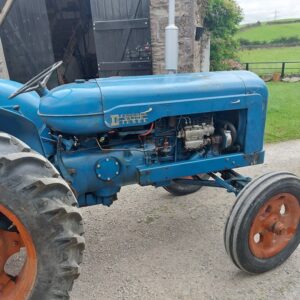 Get familiar with the tractor but exercise caution
Get familiar with the tractor but exercise caution
Check the brakes, water and oil levels throughout the tractor, he advises. “Don’t be too quick to drain the oil, it’s good to run the tractor first if possible and check for leaks, as well as brakes and hydraulics. “Safety is paramount. Make sure the handbrake or parking brake are working; commonly people will start the tractor while standing beside it – but it’s best to be sitting in the seat,” he warns. “Make sure the tractor is out of gear, with the brake on, as a lot of older tractors start in gear, which can be dangerous. “Ensure the PTO is disengaged, if it can be, and that there’s a guard on it. Some Massey Fergusons and Fords are known to have issues, where the PTO shafts won’t stop, even when they’re disengaged – which can be dangerous as well as expensive to repair.”
Don’t take it to pieces unnecessarily
If it has an oil leak, repair the leak, says Mr Duncan. “It doesn’t mean you have to completely overhaul the engine; sometimes people pull the engine, gearbox and backend to pieces when they don’t need to, then cause themselves a lot of unnecessary work and expense. “If the engine needs an overhaul then get the job done well; some makes and models are easier than others. Some have wet liners, like the Fordson Major and Nuffield range, which means you can pull the liners and fit new ones without going to an engine machinist. Some engines with dry liners need to be stripped down and sent to the machinist for a rebore, which is more expensive,” he adds.
“Some old tractors’ backends and gearboxes often go on for years and years. They might need new seals or bearings, but they’re made of good stuff. The British-made tractors, generally speaking – unless they’ve had a lot of neglect – are tough as old boots. The Fordson Major has the transmission hand brake which, if looked after, will last a lifetime, but if it has been driven with the brake on, this can cause damage.”
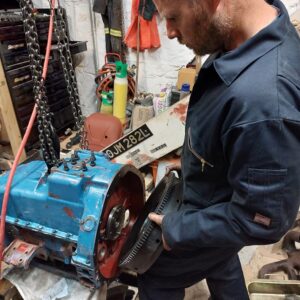 Do a bit at a time
Do a bit at a time
To fully restore a tractor is to get it back near to the condition when it came out of the factory. “Some people buy a vintage tractor and don’t do anything to it at all, but I think it is good to repair it when you have the time and money to do so. But sort out the mechanical problems before painting it,” says Mr Duncan.
“It’s good to do a bit of the tractor at a time and not completely strip everything down all at once. Always take photos of your tractor before strip down. If you are taking the engine apart, it’s good to check the timing gears and make sure that all the timing marks line up before taking them off. I have occasionally seen one of the gears a tooth out on the timing, so it’s good to get familiar with that, so when it is time to assemble again you have a little more understanding about setting them to the correct marks.”
Browse our vintage and classic farm machinery on FarmAds HERE.

